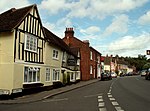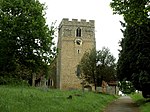Hedingham Castle
1066 establishments in EnglandBuildings and structures completed in the 12th centuryCastles in EssexGardens in EssexGrade I listed buildings in Essex ... and 4 more
Historic house museums in EssexMotte-and-bailey castlesScheduled monuments in EssexUse British English from February 2023

Hedingham Castle, in the village of Castle Hedingham, Essex, is arguably the best preserved Norman keep in England. The castle fortifications and outbuildings were built around 1100, and the keep around 1140. However, the keep is the only major medieval structure that has survived, albeit less two turrets. It is a Grade I listed building and a scheduled monument. The keep is open to the public.
Excerpt from the Wikipedia article Hedingham Castle (License: CC BY-SA 3.0, Authors, Images).Hedingham Castle
Moat Path, Essex
Geographical coordinates (GPS) Address External links Nearby Places Show on map
Geographical coordinates (GPS)
| Latitude | Longitude |
|---|---|
| N 51.9925 ° | E 0.60111111111111 ° |
Address
Hedingham Castle
Moat Path
CO9 3DJ Essex, Castle Hedingham
England, United Kingdom
Open on Google Maps







